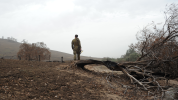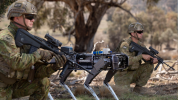Search
Using the filters to the left, click your selection, it will become bold and filter the results, click it again to remove that filter.
Reviewed by Major Andrew Maher By Caroline Moorehead, CHATTO & WINDUS - TRADE, 2019, ISBN 9781784741402, 416pp Recent discussion of the phenomenon of ‘Hybrid Warfare’ belies the history of war as a mixture of politics, deception and espionage, civilian mobilisation into irregular formations and conventional manoeuvre. World War II was typical of this mixture, particularly so in the Italian campaign. Yet, while Operation Husky (the amphibious landings in Sicily), Operation Shingle (the landings at Anzio), …

Resilience Colonel Mark Armstrong has published for the AARC an occasional paper examining the Implications of the Army Reserve call out for Operation Bushfire Assist 2019-2020 . This occasional paper explores resultant issues pertaining to improved national resilience to natural disasters. RAND have released a study examining the need for military and local government collaboration for climate adaptation. This report explores the case study of the impact of sea level rises on the Hampton Roads cluster of …

Resilience The AARC Quarter 3 Strategic Assessment has been published, which acknowledges resilience as an emerging theme relevant to land power’s contribution to Australian Defence Strategy. The Royal Commission into National Natural Disaster Arrangements recommends a ‘fundamental shift in strategic thinking about national disaster management. If there were one word that encapsulates this shift, it would be ‘resilience.’’ The Royal Commission’s report highlights that 33 people died, over 3,000 homes were …

Colonel Mark Armstrong’s Australian Army Occasional Paper ‘Every Possible Capability: Some Implications of the Army Reserve Call Out for Operation Bushfire Assist 2019-2020’ can now be downloaded from the Australian Army Research Library here . Read on below for an abstract of the paper. During the latter months of 2019 and the new year of 2020, Australia experienced catastrophic and widespread bushfires. As the situation worsened, the federal government unexpectedly called out the Australian Defence Force …

Major Power Competition The October 2020 edition of PRISM from National Defense University is focussed upon Great Power Competition. Two articles address the competition for influence in Africa which argue for sustained presence that mitigates the risk of losing influence on the continent. Similarly, the recently commenced Journal of Future Conflict (Fall 2020 edition) from Queens University in Canada takes a comparable orientation. Of note, the Journal of Future Conflict includes articles from David …

The Australian Army is in an exciting period of change and development. New strategic guidance and a generously funded force structure plan , coupled with the demand of senior leaders for change, presents opportunities for substantial enhancements to Army’s structure and capabilities. Seizing the opportunity requires innovative employment of emerging technologies grounded in real-world experience. This article will use the example of a Semi-Autonomous Combat Team concept to illustrate how disruptive …

Deterrence The Texas National Security Review have published a primer on Coercion Theory , including deterrence theory, and how it applies to contemporary geopolitics. This article has also been released in podcast format by Horns of a Dilemma . Major Power Competition Modern War Institute have released a podcast interview with Dr Jack Watling of RUSI, exploring the lessons being drawn from the Nagorno-Karabakh conflict . The interview focussed upon the surprisingly high level of attrition attained by …

In late September, the UK Chief of Defence Staff, General Sir Nick Carter launched the Integrated Operating Concept , a summary of which appeared in ETOs . This document and its launch are notable in the manner with which they articulate the threat perceived by the UK Ministry of Defence, and therefore warrant deeper analysis. Gen. Carter’s speech was hosted by General David Petraeus (ret.), available on Youtube ( here ), marked by a hawkish framing of contemporary conflict: ‘Our authoritarian rivals see …

Major Power Competition Jason Begley of the Air Power Development Centre offers a nuanced appreciation of Competitive Strategies in the Indo-Pacific , published through the Harvard Belfer Centre. This report is an extended read (approx. 2 hours) that anchors appreciation off an approach that ‘views strategic competition structurally – poised atop a hierarchy made up of smaller competitions, which are themselves comprised of discrete, single-issue contexts.’ This analysis leverages the approach taken in the …

Deterrence The UK Chief of General Staff (CGS), General Sir Mark Carleton-Smith, spoke on 29 Sep about how the UK Army is prepared for the challenges of the future. The full speech is available here , with the following quote being of note: “It is the capability to war-fight which provides the credibility to underpin a form of flexible modern deterrence – ensuring resilience in defence and unpredictability in offence – and it is this capability that drives our competitors to operate in the shadows.” This …

